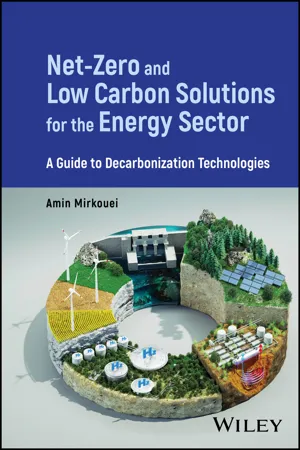
Net-Zero and Low Carbon Solutions for the Energy Sector
A Guide to Decarbonization Technologies
- English
- PDF
- Available on iOS & Android
Net-Zero and Low Carbon Solutions for the Energy Sector
A Guide to Decarbonization Technologies
About this book
Net-Zero and Low Carbon Solutions for the Energy Sector
Guide to choosing and investing in decarbonization technologies for the energy sector
Net-Zero and Low Carbon Solutions for the Energy Sector proposes mature (high technology readiness level) net-zero and low carbon pathways and technologies in the energy sector, discussing net-/near-zero solutions for producing and storing power, heat, biofuel, and hydrogen, and highlighting various pathways and processes to achieve net-zero targets and address climate concerns.
Each chapter provides a relevant case study to aid in the practical application of concepts, covering decarbonization solutions that have high potential to be used in the near future, such as solar-hybrid systems for net-zero power generation, CCUS-hybrid systems for low carbon power generation, pumped hydropower for power storage, commercial concentrating solar power plants for heat generation, gasification with CCUS for biofuel production, hybrid thermochemical process for hydrogen production, and more.
Written from the perspective of firsthand research experience in the field, this book includes information on:
- Net-zero power generation via solar, wind, hydropower, geothermal, hydrogen, and marine processes
- Near-zero power generation via nuclear, coal, natural gas, biomass, and ammonia processes
- Mechanical and battery-based power storage and heat storage via physical and thermochemical processes
- Near-zero heat generation processes and biofuels production, including biogas, biomethane, bioethanol, and biodiesel
- Hydrogen production via electrolysis and thermochemical processes with CCUS and low-emission technologies for hydrogen storage
Net-Zero and Low Carbon Solutions for the Energy Sector is a valuable resource for business professionals, academics, and policy makers who are active in contributing to net-zero emissions targets for keeping the atmospheric CO 2 levels in an acceptable range.
Frequently asked questions
- Essential is ideal for learners and professionals who enjoy exploring a wide range of subjects. Access the Essential Library with 800,000+ trusted titles and best-sellers across business, personal growth, and the humanities. Includes unlimited reading time and Standard Read Aloud voice.
- Complete: Perfect for advanced learners and researchers needing full, unrestricted access. Unlock 1.4M+ books across hundreds of subjects, including academic and specialized titles. The Complete Plan also includes advanced features like Premium Read Aloud and Research Assistant.
Please note we cannot support devices running on iOS 13 and Android 7 or earlier. Learn more about using the app.
Information
Table of contents
- Cover
- Title Page
- Copyright
- Contents
- About the Author
- Acknowledgments
- Acronyms
- List of Figures
- List of Tables
- Introduction
- Chapter 1 Power Generation (Net‐Zero Solutions)
- Chapter 2 Power Generation (Low‐Carbon Solutions)
- Chapter 3 Power Storage
- Chapter 4 Heat Generation
- Chapter 5 Heat Storage
- Chapter 6 Biofuel Production
- Chapter 7 Hydrogen Production
- Chapter 8 Hydrogen Storage
- Appendix 1 Opportunities to Study or Work with the Author
- Appendix 2 Author's Publications
- Peer-Reviewed Conference Publications
- Appendix 3 Self‐Check Questions and Answers
- Glossary
- Index
- EULA